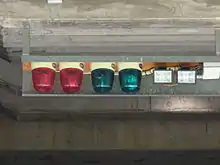Third umpire
The third umpire (or TV Umpire[1]) is an off-field umpire used in some cricket matches, particularly international matches. Their role is to make the final decision in questions referred to them by the two on-field umpires or the players.

The third umpire is also there to act as an emergency on-field umpire if required.[2]
History
The third umpire was conceptualized by former Sri Lankan domestic cricketer, and current cricket writer Mahinda Wijesinghe.
It debuted in Test cricket in November 1992 at Kingsmead, Durban for the South Africa vs. India series. Karl Liebenberg was the third umpire with Cyril Mitchley the on-field umpire, referring the run-out decision in this match. Sachin Tendulkar became the first batsman to be dismissed (run out) by using television replays in the second day of the Test scoring 11.[3]
Appointment
The third umpire is appointed from the Elite Panel of ICC Umpires or the International Panel of ICC Umpires for Test matches,[2] ODIs,[4] and T20Is.[5]
For all Test matches, and for ODIs where DRS is used, the third umpire is appointed by the ICC, and is a different nationality to the two sides. For ODIs where DRS is not used, and for all T20Is, the third umpire is appointed by the home side's Governing body.
Functions
Decision requests
An on-field umpire can, at his own discretion, use a radio link to refer particular types of close decision to the third umpire, this is called an Umpire Review. When the full Umpire Decision Review System is not in use, the third umpire uses television replays (only) to assist him in coming to a decision.[6]
When the full DRS is in use, players can also initiate reviews of particular decisions by the on-field umpires, this is called a Player Review. These are judged by the third umpire, and the third umpire has the full range of technology available beyond simple replays, for both Umpire Reviews and Player Reviews.
Emergency on-field umpire
In the case of injury or illness to one of the on-field umpires, the third umpire will take his place. The third umpire duties will then be taken on by the Fourth umpire.[7]
For example, during the 4th ODI between Australia and India at Canberra in 2015–16, umpire Richard Kettleborough was injured during Australia's innings and was replaced by third umpire Paul Wilson.[8]
References
- "Australia vs New Zealand scorecard". ESPNcricinfo. Retrieved 18 December 2019.
TV Umpires Marais Erasmus
- "ICC Men's Test Match Playing Conditions Effective 1 September 2019". ICC. 1 September 2019. Retrieved 18 December 2019.
2.1.1.3 One (1) third umpire, who shall act as the emergency on-field umpire and officiate in regard to the DRS, appointed by the ICC from the ICC Elite Panel of Umpires or the ICC International Panel of Umpires, who shall not be from the same country as the participating teams.
- "Wisden: 1st Test South Africa v India 1992–93". cricinfo.com.
- "ICC Men's One Day International Playing Conditions Effective 30 September 2018". ICC. 30 September 2018. Retrieved 23 December 2019.
2.1.7 In ODI matches where the DRS is used, the ICC will appoint a third umpire who shall act as the emergency on-field umpire and officiate in regard to the DRS. Such third umpire shall not be from the same country as the participating teams and shall be appointed from the ‘Elite Panel’ or the ‘International Panel’. 2.1.8 In all other ODI matches, the third umpire will be appointed by the Home Board and shall act as the emergency on-field umpire and officiate in regard to TV replays. Such appointment shall be made from the ‘Elite Panel’ or the ‘International Panel’.
- "ICC Men's Twenty20 International Playing Conditions Effective 28 October 2019". ICC. 28 October 2019. Retrieved 15 January 2020.
2.1.5 In all T20I matches, the third umpire will be appointed by the Home Board and shall act as the emergency on-field umpire and officiate in regard to TV replays. Such appointment shall be made from the ‘Elite Panel’ or the ‘International Panel’.
- "ICC Men's One Day International Playing Conditions Effective 30 September 2018". ICC. 30 September 2018. Retrieved 14 January 2020.
Appendix D, paragraph 1.1.6, THIRD UMPIRE (NON-DRS), Replays that can be used: The third umpire shall only have access to replays of any camera images. Other technology which may be in use by the broadcaster for broadcast purposes (for example, ball-tracking technology, sound-based edge detection technology, and heat-based edge detection technology) shall not be used during Umpire Reviews.
- "ICC Men's Test Match Playing Conditions Effective 1 September 2019". ICC. 1 September 2019. Retrieved 18 December 2019.
2.1.1.3 One (1) third umpire, who shall act as the emergency on-field umpire... 2.1.1.4 One (1) fourth umpire, who shall act as the emergency third umpire, appointed by the Home Board, from its nominees to the ICC International Panel of Umpires.
- "Finch takes out an umpire with drive". cricket.com.au. 20 January 2016. Retrieved 24 December 2019.